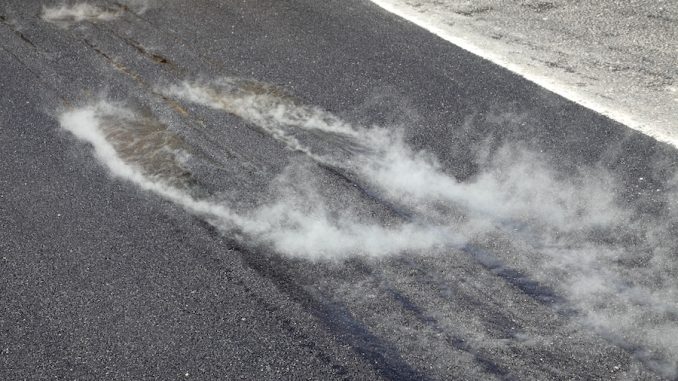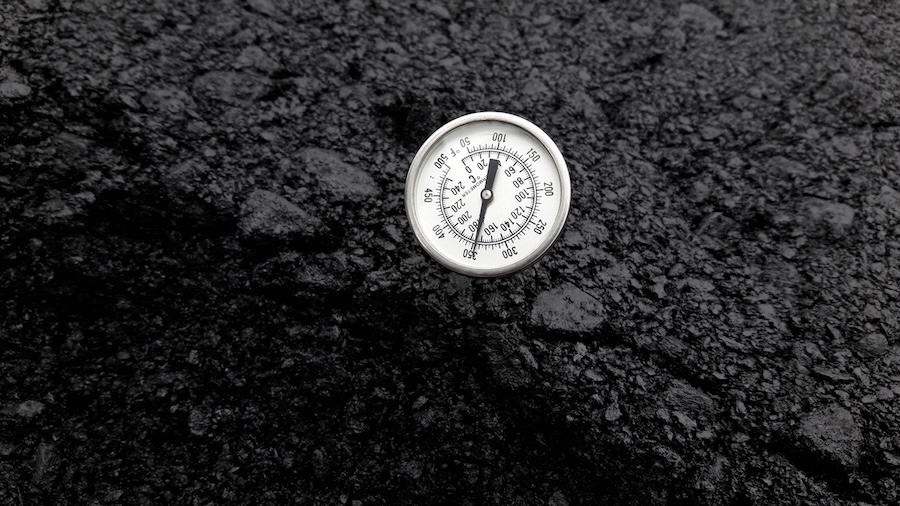
View the complete article here.
This guide will explore how asphalt’s unique properties interact with various weather conditions, impacting its application and longevity. Through detailed sections on the properties of asphalt, the influence of temperature and moisture, and the crucial interplay between these factors—this guide aims to equip contractors with the knowledge to optimize paving practices under diverse environmental conditions.
Understanding Asphalt Characteristics
Understanding the characteristics of asphalt is fundamental to successful paving operations. Asphalt’s unique composition and sensitivity to weather elements like temperature and moisture greatly influence its performance and longevity, making it crucial for contractors to manage these factors effectively during paving projects.
Properties of Asphalt
Asphalt—primarily used in road construction—is a composite material made from aggregates such as sand, gravel, and crushed stone—held together by asphalt cement, a petroleum product. This composition gives asphalt its necessary flexibility and durability. However, these same properties also make it highly sensitive to temperature changes. Asphalt cement’s viscosity varies significantly with temperature, which influences the workability of the asphalt mix and the compaction process during paving.
Impact of Temperature
Temperature is a critical factor in asphalt paving. At high temperatures, asphalt becomes more fluid and easier to work with—allowing for better compaction as the aggregates can move more freely to fill voids. Conversely, at low temperatures, the asphalt stiffens—making it challenging to achieve proper compaction. Inadequate compaction can lead to a porous pavement, decreasing its strength and making it susceptible to water infiltration—which can cause damage during freeze-thaw cycles.
Influence of Moisture
Moisture also plays a significant role in the quality and durability of asphalt. Water can seep into the asphalt through unsealed or improperly compacted surfaces, leading to a range of problems. During colder months, trapped water can freeze and expand—creating cracks and potholes. In addition, in hot conditions, moisture in the underlying layers can cause steam pockets that lead to blistering or surface deformations. The presence of water can also prevent the asphalt binder from adequately adhering to the aggregates, reducing the overall structural integrity of the pavement.
Interplay Between Temperature and Moisture
The interplay between temperature and moisture can further complicate asphalt paving. For instance, on a hot and humid day, the evaporation of moisture from the asphalt layer can cool the surface—unexpectedly accelerating the hardening process and potentially leading to premature compaction. Understanding these characteristics is crucial for contractors to adjust their paving techniques and schedules according to weather conditions to ensure the longevity and performance of asphalt pavements.
Impact of Different Weather Conditions
Weather conditions play a pivotal role in asphalt paving, significantly impacting the process and the quality of the finished pavement. From the sweltering heat of dry climates to the unpredictable gusts in windy environments, each scenario presents unique challenges and considerations.
Hot and Dry Conditions
In hot and dry conditions, the high temperatures can cause the hot mix asphalt to cool more rapidly than intended—which impacts the ability to properly compact the material. This rapid cooling can also lead to premature curing of the asphalt, risking the overall quality of the pavement as it may not be fully compacted—leading to weak spots and potential longevity issues.
Cold and Wet Conditions
Paving in cold and wet conditions presents numerous challenges, primarily due to the potential for poor compaction and extended curing times. Cold temperatures can stiffen the asphalt mix, making it difficult to work with and compact properly. In addition, moisture and freezing temperatures can adversely affect asphalt binding and compromise the structural integrity of the pavement—leading to issues such as cracking and potholing.
Windy Conditions
Wind can significantly affect asphalt paving by accelerating the cooling process of the hot mix asphalt. This can reduce the time available for compaction and negatively impact the workability of the asphalt—making it harder to achieve a smooth, durable surface.
Optimal Weather Conditions
The ideal weather conditions for asphalt paving are typically warm and dry. Temperatures should be moderate to ensure the asphalt remains workable and doesn’t cool too quickly, allowing for optimal compaction. These conditions help ensure that the asphalt can be properly laid, compacted, and cured—resulting in a durable and long-lasting pavement.

Technological Solutions and Adaptations
Technological innovations in the asphalt paving industry provide essential solutions for managing the challenges posed by varying weather conditions. From heated tarps and windbreaks to modified asphalt mixes and real-time weather monitoring, these advancements ensure that contractors can maintain high quality and efficiency in their paving projects—regardless of environmental constraints.
Heated Tarps and Windbreaks
To combat the rapid cooling of asphalt in cold or windy conditions, contractors can utilize heated tarps and windbreaks. These tools are essential for maintaining optimal asphalt temperatures during application, ensuring that the material remains workable and can be properly compacted. Heated tarps cover the asphalt to retain heat, while windbreaks reduce the cooling effects of breezes and gusts during the paving process.
Modified Asphalt Mixes
Advancements in asphalt technology have led to the development of modified asphalt mixes, which are tailored to perform better under specific weather conditions. These mixes incorporate polymers or other additives that enhance their resistance to temperature fluctuations and moisture, providing a more durable and reliable surface in extreme conditions. This adaptation is crucial for maintaining pavement integrity in regions prone to severe weather variations.
Real-time Weather Monitoring
By using weather tracking tools and apps, contractors can receive up-to-the-minute updates on local weather conditions. This information is critical for planning and adjusting paving schedules to avoid unexpected weather changes that could negatively impact the paving process. It allows for more precise timing, ensuring that paving is done during optimal weather conditions to achieve the best results.
Best Practices for Contractors
In the dynamic environment of asphalt paving, adhering to best practices is not just a recommendation—it’s a necessity. These practices should include meticulous planning and scheduling, swift on-site adjustments in response to weather changes, and rigorous communication and safety protocols to ensure both project success and worker protection under all conditions.
Planning and Scheduling
Successful asphalt paving begins with effective planning and scheduling. Contractors should closely monitor seasonal weather patterns and forecasts to align their paving projects with favorable conditions. This proactive approach helps in avoiding potential setbacks caused by adverse weather, ensuring projects stay on track and within budget.
On-Site Adjustments
Flexibility on the job site is crucial for dealing with unexpected weather changes. Contractors should train their teams to make quick on-site adjustments such as modifying the timeline of the application process or adjusting the equipment settings based on real-time weather conditions.
Communication and Safety
Clear communication is essential, particularly when weather conditions change suddenly. Contractors should ensure all team members are informed of any changes in the schedule or process due to weather adjustments. Prioritizing safety is also paramount. This includes conducting regular safety briefings and ensuring all safety protocols are followed, especially under adverse weather conditions—to protect the workforce and the project’s integrity.
View the complete article here.
How does temperature affect asphalt paving?
High temperatures make asphalt more fluid and easier to compact, while low temperatures make it stiffer and harder to compact.
What measures can contractors take to manage asphalt paving in cold or windy conditions?
Contractors can use heated tarps and windbreaks to maintain optimal asphalt temperatures and ensure proper compaction.













































